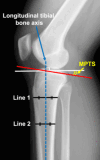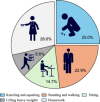Occupational motions such as kneeling and squatting are associated with the increased development of medial meniscus posterior root tears, regardless of the medial posterior tibial slope angle
- PMID: 40390861
- PMCID: PMC12086786
- DOI: 10.1002/jeo2.70276
Occupational motions such as kneeling and squatting are associated with the increased development of medial meniscus posterior root tears, regardless of the medial posterior tibial slope angle
Abstract
Purpose: The relationship between occupational motions and the medial posterior tibial slope (MPTS) with the development of medial meniscus posterior root tears (MMPRTs) has not been investigated. The development of non-traumatic degenerative MMPRTs may be influenced by repetitive occupational motions and bone morphological characteristics. Herein, we examined the association between occupational motions and MPTS in patients with MMPRT development.
Methods: During the first medical examination, MPTS was measured using lateral knee radiographic images, and occupational motions were investigated in 559 patients (591 knees). Occupational motions were classified as kneeling and squatting, standing and walking, sitting, lifting heavy weights, and housework. Mann-Whitney U test was used to compare patient characteristics between male and female patients and MPTS relative to occupational motion.
Results: The most frequent occupational motion was housework (160/559 patients, 28.6%), followed by kneeling and squatting (140/559, 25.0%), standing and walking (128/559, 22.9%), sitting (82/559, 14.7%), and lifting heavy weights (49/559, 8.8%). Furthermore, housework (10.0 ± 2.6°) involved significantly greater MPTS than kneeling and squatting (9.3 ± 2.7°; p = 0.012). However, the MPTS associated with other occupational motions was not significantly different from that associated with housework.
Conclusion: The most frequent occupational motion among patients with MMPRTs was housework, followed by kneeling and squatting. Patients who performed housework tended to have a higher MPTS. Occupational motions such as kneeling and squatting potentially increase the development of MMPRTs, even without a high MPTS.
Level of evidence: Level IV.
Keywords: kneeling; meniscus; occupational motion; posterior root tear; posterior tibial slope.
© 2025 The Author(s). Journal of Experimental Orthopaedics published by John Wiley & Sons Ltd on behalf of European Society of Sports Traumatology, Knee Surgery and Arthroscopy.
Conflict of interest statement
The authors declare no conflicts of interest.
Figures



Similar articles
-
Injury patterns of medial meniscus posterior root tears.Orthop Traumatol Surg Res. 2019 Feb;105(1):107-111. doi: 10.1016/j.otsr.2018.10.001. Epub 2018 Nov 12. Orthop Traumatol Surg Res. 2019. PMID: 30442555
-
Association between anatomical risk factors and medial meniscus posterior root tears: a retrospective study.BMC Musculoskelet Disord. 2025 May 9;26(1):455. doi: 10.1186/s12891-025-08676-y. BMC Musculoskelet Disord. 2025. PMID: 40346501 Free PMC article.
-
Posteromedial opening wedge high tibial osteotomy has favourable outcomes in simultaneous medial meniscus posterior root repair and varus medial knee osteoarthritis patients without concomitant root tear.J Orthop Surg Res. 2025 Jan 25;20(1):97. doi: 10.1186/s13018-025-05519-3. J Orthop Surg Res. 2025. PMID: 39863887 Free PMC article.
-
Increased Posterior Tibial Slope Is Associated With Increased Risk of Meniscal Root Tears: A Systematic Review.Am J Sports Med. 2024 Nov;52(13):3427-3435. doi: 10.1177/03635465231225981. Epub 2024 Feb 16. Am J Sports Med. 2024. PMID: 38362610
-
Osteoarthritis and meniscus disorders of the knee as occupational diseases of miners.Occup Environ Med. 2005 Aug;62(8):567-75. doi: 10.1136/oem.2004.017137. Occup Environ Med. 2005. PMID: 16046610 Free PMC article. Review.
References
-
- Altinayak H, Karatekin YS. Increased medial femoral condyle angle and narrow intercondylar notch are associated with medial meniscus posterior root tear. Arthroscopy. 2023;39:2154–2163. - PubMed
-
- Bogas Droy H, Dardenne T, Djebara A, Pujol N. Long‐term clinical and radiological outcomes after arthroscopic partial meniscectomy on stable knees are better for traumatic tears when compared to degenerative lesions: a systematic review. Knee Surg Sports Traumatol Arthrosc. 2025;33:107–123. - PubMed
-
- Chang PS, Radtke L, Ward P, Brophy RH. Midterm outcomes of posterior medial meniscus root tear repair: a systematic review. Am J Sports Med. 2022;50:545–553. - PubMed
LinkOut - more resources
Full Text Sources
Research Materials

